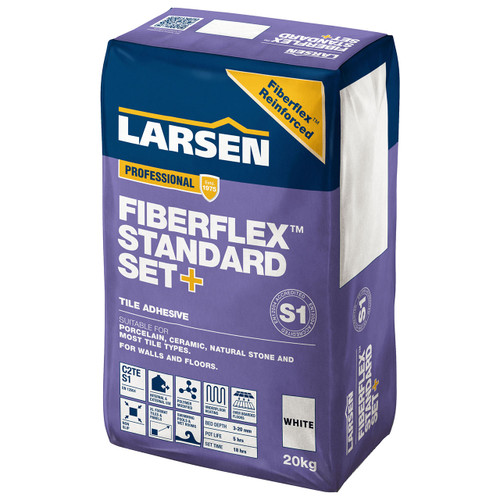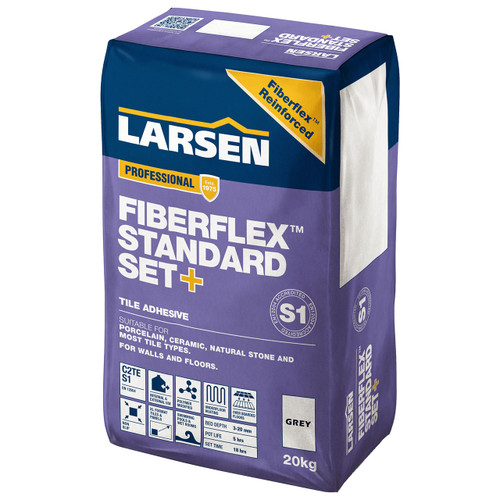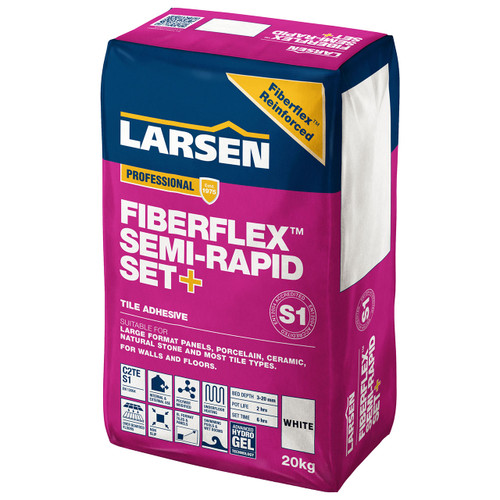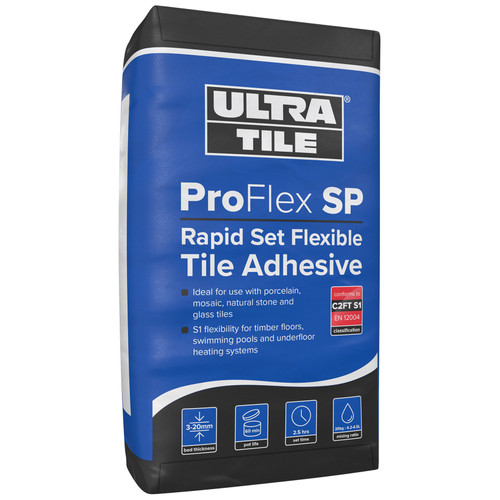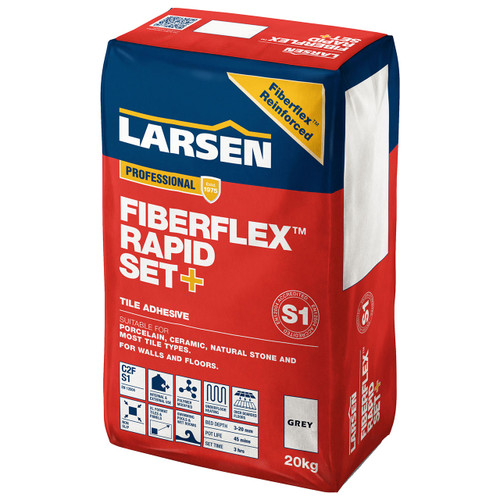
Larsen Pro Flexible Rapid Set Floor & Wall Adhesive - WHITE - 20kg
Larsen Pro Flexible Rapid Set Floor & Wall Adhesive - WHITE - 20kg
Professional Flexible Rapid Set+ is a specially formulated, fully flexible, S1 rated, fast setting, cement based adhesive. It is suitable for beds of 3 - 20mm, interior, exterior, floor and wall applications.
Professional Flexible Rapid Set+ is a specially formulated, fully flexible, S1 rated, fast setting, cement based adhesive. It is suitable for beds of 3 - 20mm, interior, exterior, floor and wall applications.
Professional Flexible Rapid Set+ is suitable for fixing most types of tiles and is recommended for fixing glass mosaic, porcelain, natural stone and large format tiles. It is recommended for use on more demanding substrates including heated screeds, overboarded timber and swimming pools.
- Deformable
- Grout after 18 hours
- BS EN 12004 Type C2FS S1
- Pot Life - Approx 45 minutes
Packaging:
20 kg multiwall, sealed, paper sacks
Coverage:
4 sq./m per 20kg bag @ 3mm bed
DIRECTIONS FOR USE
PREPARATION
General All substrates must be suitably dry and comply with the recommendations in the British Standards and TTA Guidance documents. All substrates should be clean and thoroughly sound; they should be free from standing water, oils, grease, dust, loose particles or any other contaminants which may interfere with adhesion.
Gypsum Based Screeds Gypsum based screeds require mechanical preparation by buffing, vacuuming etc. The screed must be tested to ensure it is dry (less than 0.5% moisture content measured by CM). All gypsum based screeds should be primed as follows: first coat Acrylic Primer diluted 1:1 with water and allowed to dry; second coat Acrylic Primer applied neat and allowed to dry fully. If particularly absorbent, subsequent coats may be required.
Gypsum Plaster Gypsum plaster on walls is suitable for a weight of tiles and adhesive of up to 20kg/m'. Plaster should not be dusty or overly polished and should be primed with Larsen Acrylic Primer.
Underfloor Heating New heating systems must have been trialled at a high temperature for a period of at least 48 hours in advance of tiling. Ensure the heating is turned off at least 48 hours before any tiling work is carried out and not turned on until at least 7 days after the work has been completed. Heating should be turned on at the lowest setting and the temperature increased by no more than 5°C per 24 hours. Particular attention should be given to ensure there is adequate provision for movement joints in the tiling.
Timber Substrates Timber substrates must be sufficiently rigid and supported to be free from excessive deflection under expected loads. Ensure adequate ventilation exists beneath the floor. Ensure all new wood (including joists) is 'dry' and conditioned. The floor should be designed to accommodate both seasonal changes in moisture and the changes caused by step changes in heating. Extra joists/noggins should be added to strengthen the floor as required. In wet areas timber substrates must be suitably tanked. Plywood on walls is suitable for a weight of tiles and adhesive of up to 32kg/m'.
Plywood or Chipboard: Plywood should be at least 18 mm exterior grade and chipboard should be flooring grade. Boards should be free from any wax or other coating which may impair bond. Ensure surface is free from contamination and that the backs and edges of all boards are sealed against moisture ingress. Screw fix the boards at 300 mm centres and at 150 mm centres along joints. Ensure all edges are fully supported along joists or noggins.
If insufficient support exists to allow this or if excess deflection is evident, extra noggins/joists should be added or consideration given to overboarding. Plywood overlays should be at least 15mm thick. Ensure surface is free from contamination and that the backs and edges of all boards are sealed against moisture ingress. Screw fix the boards at 300 mm centres and at 150 mm centres along joints. Ensure screwed to joists and noggins, not just original boards. Joints between boards should be staggered with original joints.
Movement Joints It is important to ensure that there is adequate provision of movement joints in all wall and floor tiling, It is recommended to follow the guidance provided in BS 5385 and by the Tile Association and proprietary joint manufacturers. Ideally, movement joints should be detailed by the designer at the outset. For further information or for situations which are not covered above, consult our website or contact our Technical Dept.
PRIMING
Larsen Acrylic Primer should be used to prime surfaces when required. On porous substrates, dilute 1:1 with clean water and allow to dry before applying adhesive. On impervious substrates, apply primer neat and allow to dry. Tiling should be carried out when the primer has dried clear but remains tacky.
MIXING
The adhesive should be added to clean water (approx. 4.5L water/20kg) adhesive and mixed with a suitable forced action mixer or slow speed drill and paddle until a slump free mortar is produced. The mixed adhesive is usable for up to 45 minutes depending on site temperature and conditions. Do not attempt to remix adhesive or add extra water after it has begun to stiffen as this will cause a loss in performance.
APPLICATION
The mixed adhesive should be applied to dry areas on walls using a suitable notched trowel and applied by solid bed on wet areas on walls, on all exterior tiling and on all floor tiling. In addition, when fitting large format tiles it is highly recommended to also fully skim the back of the tile with a thin layer of adhesive. Tiles should be placed with a firm twisting action before the adhesive has skinned over, i.e. within the open time. Regularly check to ensure adequate contact between adhesive, tile and substrate. 'Dot and Dab' method of fixing is not suitable.
GROUTING
Only grout when the tile adhesive has set. Typically this is within 18 hours for standard setting adhesives and within 3 hours for fast setting adhesives.
RESTRICTIONS
'Dot and Dab' method of fixing is not suitable. Tiles should not be fixed to wooden substrates externally or in wet areas. Excessive deflection/movement resulting from incorrect preparation will result in cracking of tiles and/or debonding. Floating Timber and Laminate floors are not recommended substrates for direct fixing of rigid floor finishes. Pale coloured marble/porcelain can be translucent and dark coloured adhesive can sometimes show through. If in doubt we would always recommend tiling a small trial area using a white adhesive and back buttering the tiles to ensure a uniform adhesive coverage. Cement-based products will take longer to harden and set at lower temperatures, and should not be used below 5°C. All tiling should be carried to current best practice, including British Standards and TTA Guidance documents.




